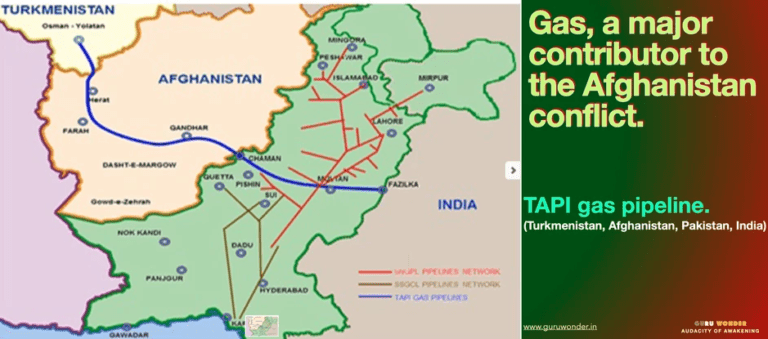![]()
This is in continuation from the last two articles –
Afghanisthan – blessed and cursed by geography
What was America doing before 9/11
The foundation of the modern global economy is driven by the default currency which is the United States dollar. In turn the dollar’s value is pegged to the price of oil, making control and distribution of this vital energy source oil and gas extremely important.
Afghanistan has 7 neighbours. Pakistan to the South and Iran to the West, the Central Asian Republics (CIS countries), of Turkmenistan, Uzbekistan and Tajikistan lie to the North, and China to the West and Pakistan occupied Indian territory in the South East.
The CIS countries are extremely rich in gas deposits, and Turkmenistan alone possesses the 4th largest gas deposits in the world, only after Qatar, Iran and Russia. The only feasible way to export this gas from Turkmenistan is by overland pipelines costing tens of billions of dollars.
Earlier Soviet Union and Iran by allowing the gas to connect to their pipelines had a controlling duopoly over gas supplies and pricing and raked in huge profits at the expense of the CIS countries.
After the disintegration of the Soviet Union, China stepped in and now pipes a large chunk of gas over a distance of 7000 km starting from the North Eastern gas fields of Turkmenistan right up to Shanghai to meet Chinese demand, in a win-win arrangement.
But what is to be done about exploiting the huge deposits of gas at Dauletabad in the south of Turkmenistan? India is a big gas market and therefore it made sense to similarly pipe gas to India after going overland through Afghanistan and Pakistan while meeting their gas demand too. Logistics and technology have never been a problem, but security is a big threat.
So in 1997 the Central Asian Gas Pipeline Consortium led by Unocal of USA, with partners from Turkmenistan, Saudi Arabia, Japan, Indonesia, Korea and Pakistan made a deal with the Afghan Taliban and the Pakistanis in a meeting in Texas, to purchase and allow transit of oil and gas through their countries. All parties signed off on the US$ 10 billion TAPI (Turkmenistan, Afghanistan, Pakistan, India) gas pipeline.
Afghanistan is not a nation state, but is actually made up of numerous small self sufficient fiercely independent territories who over millennia have owed allegiance to no one except themselves.
So while the consortium pushed for the project, Qatar and others to make sure the project was scuttled if not indefinitely delayed. It supported terrorist groups in Afghanistan through Pakistan’s infamous terror network run by the ISI and a plethora of fronts posing as charities in the name of supporting Islam. This was to ensure that Turkmenistan gas remained off the market and thus Qatar retained its dominant role in the global gas market and retain its profitability. This also helps explain why Qatar has so much influence over Pakistan and the Taliban.
Keen to control and buy the gas from Turkmenistan’s Dauletabad gas field, rather than see it piped to India, China too was playing the same game of supporting and arming the Taliban to disrupt the project.
Democracies are messy and unpredictable and not so easy to control, so America for all its talk on human rights and democracy always favours dealing with totalitarian regimes. American leadership consider themselves experts at regime change.
It became imperative that Pakistan democracy had to be overthrown and a pliant, corrupt, military regime be put in place in Pakistan and this was done in 1977 by way of a military coup led by General Zia-ul-Haq.
The Taliban leadership driven solely by impractical religious zeal and led by many local commanders proved completely inept at managing Afghanistan and its economy. It soon became apparent that the Taliban would not be able to deliver support for the TAPI pipeline. So plans were hatched and the right time was awaited for a regime change in Afghanistan also.
The 9/11 incident provided a perfect excuse and America mounted a full fledged invasion of Afghanistan to throw out the Taliban and install a pro American government staffed by Afghan Americans in key positions of a democratic Afghan leadership.
The new Afghan regime proved ineffective in dealing with violence and security and this regime change was proving to be an extremely expensive solution.
Who will pay the US$ 2.26 trillion bill?
This war was financed by raising debt from American financiers and will be paid off over a 20 year period. The US government will print more money which will lead to inflation and lower the standard of living of ordinary Americans blinded by their misguided nationalistic and patriotic fervour.
In summary much of the US$ 2.26 trillion went from the American population to financiers, military industrial complex etc. via Afghanistan and Pakistan.
Former American President Donald Trump understood this game very well. Unbeholden to the Military-Industrial complex and being the astute businessman asked the fundamental question “What the hell is America doing in Afghanistan? and “Why should the people of America and Afghanistan suffer for this stupid 20 year long blunder?” He was attacked for lacking patriotism but he stuck to his guns.
Trump decided, instead of continuing to steamroll the Afghan Taliban, better to cut a deal with them. So a secret deal was agreed upon in Doha (Qatar) where America agreed to exit and pave the way for the only alternate possibility, the Taliban regime to form the government in Kabul, provided Taliban would actively support American business, defence and security demands. The condition was America would remain Numero Uno in Afghanistan but from a distance.
This explains why America excluded the legitimate Afghan government from the talks. This is why America left a huge arsenal of arms, ammunition and world class infrastructure for the use of the Taliban for its security and progress. Simultaneously America withdrew expert contractors who manned many of the critical defence and civilian infrastructure.
This paved the way for 60,000 Taliban soldiers to simply walk over Afghanistan and take charge.
This is why America has been apologists for the Taliban, wanting to give them ample opportunity to settle in and govern effectively.
Now what is likely to happen going forward from today will be covered in the next article.
Interesting Links
-
Pipeline Politics: Oil, Gas And The US Interest In Afghanistan ~ Outlook Magazine
-
Afghanistan, blessed and cursed by geography. – Guru Wonder
-
What was America doing in Afghanistan before 9/11? ~ Guru Wonder
-
Proposed Gas Pipeline TAPI and IPI (Turkmenistan, Afghanistan, Pakistan, India) ~ YouTube
-
War in Afghanistan: What does it mean for the future of the TAPI Gas Pipeline? ~ YouTube
-
Central Asia–China gas pipeline – Wikipedia
-
Pakistan created terror groups to check India and Afghanistan: Former US diplomats ~ The Economic Times
#Afghanistan #America #gas #India #Islam #Jihad #Oil #Pakistan #pipeline #Qatar #Russia #SaudiArabia #Taliban #Turkmenistan #Tapi







